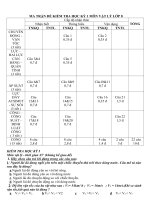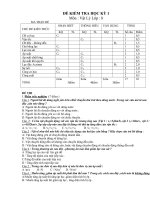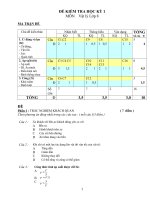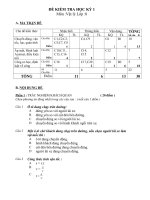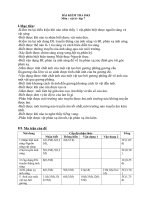Đáp án OCA 1z0 062 đề 2
Bạn đang xem bản rút gọn của tài liệu. Xem và tải ngay bản đầy đủ của tài liệu tại đây (237.48 KB, 19 trang )
Câu 1:
You find this query being used in your Oracle 12c database:
Which method a used by the optimizer to limit the rows being returned?
Trả lời:
[A]. A filter is added to the table query dynamically using ROWNUM to limit the rows to
20 percent of the total rows
[B]. All the rows are returned to the client or middle tier but only the first 20 percent are
returned to the screen or the application.
[C]. A view is created during execution and a filter on the view limits the rows to 20
percent of the total rows.
[D]. A TOP-N query is created to limit the rows to 20 percent of the total rows
Hướng dẫn:
C
Câu 2:
The user SCOTT owns the CUST table that is placed in the SALES tablespace. The
user SCOTT opens a session and executes commands as follows:
SQL> INSERT INTO cust VALUES(101, 'JACK');
1 row created.
SQL> INSERT INTO cust VALUES(102, 'SMITH');
1 row created.
As a DBA, you execute the following command from another session:
ALTER TABLESPACE sales READ ONLY;
Which statement is true regarding the effect of this command on the transaction in
Scott's session?
Trả lời:
[A]. The command fails as a transaction is still pending.
[B]. The transaction in Scott's session is rolled back and the tablespace becomes
readonly.
[C]. The command waits and the user SCOTT can execute data manipulation language
(DML) statements only as part of the current transaction.
[D]. The command hangs until all transactions on the objects in the tablespace commit
or rollback, and then the tablespace is placed in readonly mode.
Hướng dẫn:
C
You can issue the ALTER TABLESPACE…READ ONLY statement while the database
is processing transactions. After the statement is issued, the tablespace is put into a
transitional read-only state. No transactions are allowed to make further changes (using
DML statements) to the tablespace. If a transaction attempts further changes, it is
terminated and rolled back. However, transactions that already made changes and that
attempt no further changes are allowed to commit or roll back.
Câu 3:
To implement Automatic Management (AMM), you set the following parameters:
When you try to start the database instance with these parameter settings, you receive
the following error message:
SQL > startup
ORA-00824: cannot set SGA_TARGET or MEMORY_TARGET due to existing internal
settings, see alert log for more information.
Identify the reason the instance failed to start.
Trả lời:
[A]. The PGA_AGGREGATE_TARGET parameter is set to zero.
[B]. The STATISTICS_LEVEL parameter is set to BASIC.
[C]. Both the SGA_TARGET and MEMORY_TARGET parameters are set.
[D]. The SGA_MAX_SIZE and SGA_TARGET parameter values are not equal.
Hướng dẫn:
B
Example:
SQL> startup force
ORA-00824: cannot set SGA_TARGET or MEMORY_TARGET due to existing internal
settings
ORA-00848: STATISTICS_LEVEL cannot be set to BASIC with SGA_TARGET or
MEMORY_TARGET
Câu 4:
Examine the memory-related parameters set in the SPFILE of an Oracle database:
memory_max_target—6G
memory_target=5G
pga_aggregate_target=500M
sga_max_size=0
sga_target=0
Which statement is true?
Trả lời:
[A]. Only SGA components are sized automatically.
[B]. Memory is dynamically re-allocated between the SGA and PGA as needed.
[C]. The size of the PGA cannot grow automatically beyond 500 MB.
[D]. The value of the MEMORY_TARGET parameter cannot be changed dynamically.
Hướng dẫn:
C
Câu 5:
Which task would you recommend before using the Database Upgrade Assistant
(DBUA) to upgrade a single-instance Oracle 11g R2 database to Oracle Database 12c?
Trả lời:
[A]. shutting down the database instance that is being upgraded
[B]. executing the catctl.pl script to run the upgrade processes in parallel
[C]. running the Pre-Upgrade Information Tool
[D]. copying the listener.ora file to the new ORACLE_HOME
Hướng dẫn:
C
References:
Câu 6:
Examine the query and its output:
SQL> SELECT REASON, metric_value FROM dba_outstanding_alerts;
REASONMETRIC_VALUE
----------------------------------- ------------------Tablespace [TEST] is [28 perce 28.125
nt] full
Metrics "Current Logons Count"29
Metrics "Database Time Spent99.0375405
waiting (%)" is at 99.03754 for
event class "Application"
db_recovery_file_dest_size of97
4294967296 bytes is 97.298 used
and has 116228096 remaining
bytes available.
After 30 minutes, you execute the same query:
SQL> SELECT reason, metric_value FROM dba_outstanding_alerets;
REASONMETRIC_VALUE
------------------------------ --------------Tablespace [TEST] is [28 percs 28.125
nt] full
What might have caused three of the alerts to disappear?
Trả lời:
[A]. The threshold alerts were cleared and transferred to d0A_alert_history.
[B]. An Automatic Workload Repository (AWR) snapshot was taken before the
execution of the second
[C]. An Automatic Database Diagnostic Monitor (ADOM) report was generated before
the execution of the second query.
[D]. The database instance was restarted before the execution of the second query.
Hướng dẫn:
D
Câu 7:
Identify two situations in which the alert log file is updated.
Trả lời:
[A]. Running a query on a table returns ORA-600: Internal Error.
[B]. Inserting a value into a table returns ORA-01722: invalid number.
[C]. Creating a table returns ORA-00955: name us already in used by an existing
objects.
[D]. Inserting a value into a table returns ORA-00001: unique constraint
(SYS.OK_TECHP) violated.
[E]. Rebuilding an index using ALTER INDEX . . . REBUILD fails with an ORA-01578:
ORACLE data block corrupted (file # 14, block # 50) error.
Hướng dẫn:
A
E
The alert log is a chronological log of messages and errors, and includes the following
items:
*All internal errors (ORA-600), block corruption errors (ORA-1578), and deadlock errors
(ORA-60) that occur
* Administrative operations, such as CREATE, ALTER, and DROP statements and
STARTUP, SHUTDOWN, and ARCHIVELOG statements
* Messages and errors relating to the functions of shared server and dispatcher
processes
* Errors occurring during the automatic refresh of a materialized view
* The values of all initialization parameters that had nondefault values at the time the
database and instance start
Note:
* The alert log file (also referred to as the ALERT.LOG) is a chronological log of
messages and errors written out by an Oracle Database. Typical messages found in this
file is: database startup, shutdown, log switches, space errors, etc. This file should
constantly be monitored to detect unexpected messages and corruptions.
Câu 8:
Which three statements are true about a job chain?
Trả lời:
[A]. It can contain a nested chain of jobs.
[B]. It can be used to implement dependency-based scheduling.
[C]. It cannot invoke the same program or nested chain in multiple steps in the chain.
[D]. It cannot have more than one dependency.
[E]. It can be executed using event-based or time-based schedules.
Hướng dẫn:
A
B
E
References:
Câu 9:
A warehouse fact table in your Oracle 12c Database is range-partitioned by month and
accessed frequently with queries that span multiple partitions
The table has a local prefixed, range partitioned index.
Some of these queries access very few rows in some partitions and all the rows in other
partitions, but these queries still perform a full scan for all accessed partitions.
This commonly occurs when the range of dates begins at the end of a month or ends
close to the start of a month.
You want an execution plan to be generated that uses indexed access when only a few
rows are accessed from a segment, while still allowing full scans for segments where
many rows are returned.
Which three methods could transparently help to achieve this result?
Trả lời:
[A]. Using a partial local Index on the warehouse fact table month column with indexing
disabled to the table partitions that return most of their rows to the queries.
[B]. Using a partial local Index on the warehouse fact table month column with indexing
disabled for the table partitions that return a few rows to the queries.
[C]. Using a partitioned view that does a UNION ALL query on the partitions of the
warehouse fact table, which retains the existing local partitioned column.
[D]. Converting the partitioned table to a partitioned view that does a UNION ALL query
on the monthly tables, which retains the existing local partitioned column.
[E]. Using a partial global index on the warehouse fact table month column with indexing
disabling for the table partitions that return most of their rows to the queries.
[F]. Using a partial global index on the warehouse fact table month column with indexing
disabled for the table partitions that return a few rows to the queries.
Hướng dẫn:
B
C
E
Note:
* Oracle 12c now provides the ability to index a subset of partitions and to exclude the
others.
Local and global indexes can now be created on a subset of the partitions of a table.
Partial Global indexes provide more flexibility in index creation for partitioned tables. For
example, index segments can be omitted for the most recent partitions to ensure
maximum data ingest rates without impacting the overall data model and access for the
partitioned object.
Partial Global Indexes save space and improve performance during loads and queries.
This feature supports global indexes that include or index a certain subset of table
partitions or subpartitions, and exclude the others. This operation is supported using a
default table indexing property. When a table is created or altered, a default indexing
property can be specified for the table or its partitions.
Câu 10:
You support Oracle Database 12c Oracle Database 11g, and Oracle Database log on
the same server.
All databases of all versions use Automatic Storage Management (ASM).
Which three statements are true about the ASM disk group compatibility attributes that
are set for a disk group?
Trả lời:
[A]. The ASM compatibility attribute controls the format of the disk group metadata.
[B]. RDBMS compatibility together with the database version determines whether a
database Instance can mount the ASM disk group.
[C]. The RDBMS compatibility setting allows only databases set to the same version as
the compatibility value, to mount the ASM disk group.
[D]. The ASM compatibility attribute determines some of the ASM features that may be
used by the Oracle disk group.
[E]. The ADVM compatibility attribute determines the ACFS features that may be used
by the Oracle 10 g database.
Hướng dẫn:
A
B
D
AD: The value for the disk group COMPATIBLE.ASM attribute determines the minimum
software version for an Oracle ASM instance that can use the disk group. This setting
also affects the format of the data structures for the Oracle ASM metadata on the disk.
B: The value for the disk group COMPATIBLE.RDBMS attribute determines the
minimum COMPATIBLE database initialization parameter setting for any database
instance that is allowed to use the disk group. Before advancing the
COMPATIBLE.RDBMS attribute, ensure that the values for the COMPATIBLE
initialization parameter for all of the databases that access the disk group are set to at
least the value of the new setting for COMPATIBLE.RDBMS.
For example, if the COMPATIBLE initialization parameters of the databases are set to
either 11.1 or 11.2, then COMPATIBLE.RDBMS can be set to any value between 10.1
and 11.1 inclusively.
Not E:
/The value for the disk group COMPATIBLE.ADVM attribute determines whether the disk
group can contain Oracle ASM volumes. The value must be set to 11.2 or higher. Before
setting this attribute, the COMPATIBLE.ASM value must be 11.2 or higher. Also, the
Oracle ADVM volume drivers must be loaded in the supported environment.
/ You can create an Oracle ASM Dynamic Volume Manager (Oracle ADVM) volume in a
disk group. The volume device associated with the dynamic volume can then be used to
host an Oracle ACFS file system.
The compatibility parameters COMPATIBLE.ASM and COMPATIBLE.ADVM must be
set to 11.2 or higher for the disk group.
Note:
* The disk group attributes that determine compatibility are COMPATIBLE.ASM,
COMPATIBLE.RDBMS. and COMPATIBLE.ADVM. The COMPATIBLE.ASM and
COMPATIBLE.RDBMS attribute settings determine the minimum Oracle Database
software version numbers that a system can use for Oracle ASM and the database
instance types respectively. For example, if the Oracle ASM compatibility setting is 11.2,
and RDBMS compatibility is set to 11.1, then the Oracle ASM software version must be
at least 11.2, and the Oracle Database client software version must be at least 11.1. The
COMPATIBLE.ADVM attribute determines whether the Oracle ASM Dynamic Volume
Manager feature can create an volume in a disk group.
Câu 11:
Which three tasks can be automatically performed by the Automatic Data Optimization
feature of Information lifecycle Management (ILM)?
Trả lời:
[A]. Tracking the most recent read time for a table segment in a user tablespace
[B]. Tracking the most recent write time for a table segment in a user tablespace
[C]. Tracking insert time by row for table rows
[D]. Tracking the most recent write time for a table block
[E]. Tracking the most recent read time for a table segment in the SYSAUX tablespace
[F]. Tracking the most recent write time for a table segment in the SYSAUX tablespace
Hướng dẫn:
A
B
D
Incorrect:
Not E, Not F When Heat Map is enabled, all accesses are tracked by the in-memory
activity tracking module. Objects in the SYSTEM and SYSAUX tablespaces are not
tracked.
* To implement your ILM strategy, you can use Heat Map in Oracle Database to track
data access and modification.
Heat Map provides data access tracking at the segment-level and data modification
tracking at the segment and row level.
* To implement your ILM strategy, you can use Heat Map in Oracle Database to track
data access and modification. You can also use Automatic Data Optimization (ADO) to
automate the compression and movement of data between different tiers of storage
within the database.
References:
Câu 12:
What is the effect of specifying the "ENABLE PLUGGABLE DATABASE" clause in a
"CREATE DATABASE" statement?
Trả lời:
[A]. It will create a multitenant container database (CDB) with only the root opened.
[B]. It will create a CDB with root opened and seed read only.
[C]. It will create a CDB with root and seed opened and one PDB mounted.
[D]. It will create a CDB that must be plugged into an existing CDB.
[E]. It will create a CDB with root opened and seed mounted.
Hướng dẫn:
B
* The CREATE DATABASE ... ENABLE PLUGGABLE DATABASE SQL statement
creates a new CDB. If you do not specify the ENABLE PLUGGABLE DATABASE
clause, then the newly created database is a non-CDB and can never contain PDBs.
Along with the root (CDB$ROOT), Oracle Database automatically creates a seed PDB
(PDB$SEED). The following graphic shows a newly created CDB:
* Creating a PDB
Rather than constructing the data dictionary tables that define an empty PDB from
scratch, and then populating its Obj$ and Dependency$ tables, the empty PDB is
created when the CDB is created. (Here, we use empty to mean containing no
customer-created artifacts.) It is referred to as the seed PDB and has the name
PDB$Seed. Every CDB non-negotiably contains a seed PDB; it is non-negotiably always
open in read-only mode. This has no conceptual significance; rather, it is just an
optimization device. The create PDB operation is implemented as a special case of the
clone PDB operation.
Câu 13:
In your multitenant container database (CDB) containing same pluggable databases
(PDBs), you execute the following commands in the root container:
Which two statements are true?
Trả lời:
[A]. The C # # ROLE1 role is created in the root database and all the PDBs.
[B]. The C # # ROLE1 role is created only in the root database because the container
clause is not used.
[C]. Privileges are granted to the C##A_ADMIN user only in the root database.
[D]. Privileges are granted to the C##A_ADMIN user in the root database and all PDBs.
[E]. The statement for granting a role to a user fails because the CONTAINER clause is
not used.
Hướng dẫn:
A
C
* You can include the CONTAINER clause in several SQL statements, such as the
CREATE USER, ALTER USER, CREATE ROLE, GRANT, REVOKE, and ALTER
SYSTEM statements.
* * CREATE ROLE with CONTAINER (optional) clause
/ CONTAINER = ALL
Creates a common role.
/ CONTAINER = CURRENT
Creates a local role in the current PDB.
Câu 14:
Which two statements are true about extents?
Trả lời:
[A]. Blocks belonging to an extent can be spread across multiple data files.
[B]. Data blocks in an extent are logically contiguous but can be non-contiguous on disk.
[C]. The blocks of a newly allocated extent, although free, may have been used before.
[D]. Data blocks in an extent are automatically reclaimed for use by other objects in a
tablespaee when all the rows in a table are deleted.
Hướng dẫn:
B
C
Câu 15:
Examine the following impdp command to import a database over the network from a
pre-12c Oracle database (source):
Which three are prerequisites for successful execution of the command?
Trả lời:
[A]. The import operation must be performed by a user on the target database with the
DATAPUMP_IMP_FULL_DATABASE role, and the database link must connect to a user
on the source database with the DATAPUMP_EXD_FULL_DATABASE role.
[B]. All the user-defined tablespaces must be in read-only mode on the source
database.
[C]. The export dump file must be created before starting the import on the target
database.
[D]. The source and target database must be running on the same platform with the
same endianness.
[E]. The path of data files on the target database must be the same as that on the
source database.
[F]. The impdp operation must be performed by the same user that performed the expdp
operation.
Hướng dẫn:
A
B
D
In this case we have run the impdp without performing any conversion if endian format is
different then we have to first perform conversion.
Câu 16:
In a recent Automatic Workload Repository (AWR) report for your database, you notice a
high number of buffer busy waits. The database consists of locally managed tablespaces
with free list managed segments.
On further investigation, you find that buffer busy waits is caused by contention on data
blocks.
Which option would you consider first to decrease the wait event immediately?
Trả lời:
[A]. Decreasing PCTUSED
[B]. Decreasing PCTFREE
[C]. Increasing the number of DBWN process
[D]. Using Automatic Segment Space Management (ASSM)
[E]. Increasing db_buffer_cache based on the
recommendation
V$DB_CACHE_ADVICE
Hướng dẫn:
D
* Automatic segment space management (ASSM) is a simpler and more efficient way of
managing space within a segment. It completely eliminates any need to specify and tune
the pctused,freelists, and freelist groups storage parameters for schema objects created
in the tablespace. If any of these attributes are specified, they are ignored.
* Oracle introduced Automatic Segment Storage Management (ASSM) as a replacement
for traditional freelists management which used one-way linked-lists to manage free
blocks with tables and indexes. ASSM is commonly called "bitmap freelists" because
that is how Oracle implement the internal data structures for free block management.
Note:
* Buffer busy waits are most commonly associated with segment header contention
onside the data buffer pool (db_cache_size, etc.).
* The most common remedies for high buffer busy waits include database writer
(DBWR) contention tuning, adding freelists (or ASSM), and adding missing indexes.
Câu 17:
You run a script that completes successfully using SQL*Plus that performs these
actions:
1. Creates a multitenant container database (CDB)
2. Plugs in three pluggable databases (PDBs)
3. Shuts down the CDB instance
4. Starts up the CDB instance using STARTUP OPEN READ WRITE
Which two statements are true about the outcome after running the script?
Trả lời:
[A]. The seed will be in mount state.
[B]. The seed will be opened read-only.
[C]. The seed will be opened read/write.
[D]. The other PDBs will be in mount state.
[E]. The other PDBs will be opened read-only.
[F]. The PDBs will be opened read/write.
Hướng dẫn:
B
D
B: The seed is always read-only.
D: Pluggable databases can be started and stopped using SQL*Plus commands or the
ALTER PLUGGABLE DATABASE command.
Câu 18:
Which two statements are true about Oracle Managed Files (OMF)?
Trả lời:
[A]. OMF cannot be used in a database that already has data files created with
user-specified directions.
[B]. The file system directions that are specified by OMF parameters are created
automatically.
[C]. OMF can be used with ASM disk groups, as well as with raw devices, for better file
management.
[D]. OMF automatically creates unique file names for table spaces and control files.
[E]. OMF may affect the location of the redo log files and archived log files.
Hướng dẫn:
D
E
D: The database internally uses standard file system interfaces to create and delete files
as needed for the following database structures:
Tablespaces
Redo log files
Control files
Archived logs
Block change tracking files
Flashback logs
RMAN backups
Note:
* Using Oracle-managed files simplifies the administration of an Oracle Database.
Oracle-managed files eliminate the need for you, the DBA, to directly manage the
operating system files that make up an Oracle Database. With Oracle-managed files,
you specify file system directories in which the database automatically creates, names,
and manages files at the database object level. For example, you need only specify that
you want to create a tablespace; you do not need to specify the name and path of the
tablespace's datafile with the DATAFILE clause.
/> />References:
Câu 19:
You are the DBA supporting an Oracle 11g Release 2 database and wish to move a
table containing several DATE, CHAR, VARCHAR2, and NUMBER data types, and the
table’s indexes, to another tablespace.
The table does not have a primary key and is used by an OLTP application.
Which technique will move the table and indexes while maintaining the highest level of
availability to the application?
Trả lời:
[A]. Oracle Data Pump.
[B]. An ALTER TABLE MOVE to move the table and ALTER INDEX REBUILD to move
the indexes.
[C]. An ALTER TABLE MOVE to move the table and ALTER INDEX REBUILD ONLINE
to move the indexes.
[D]. Online Table Redefinition.
[E]. Edition-Based Table Redefinition.
Hướng dẫn:
D
* Oracle Database provides a mechanism to make table structure modifications without
significantly affecting the availability of the table. The mechanism is called online table
redefinition. Redefining tables online provides a substantial increase in availability
compared to traditional methods of redefining tables.
* To redefine a table online:
Choose the redefinition method: by key or by rowid
* By key—Select a primary key or pseudo-primary key to use for the redefinition.
Pseudo-primary keys are unique keys with all component columns having NOT NULL
constraints. For this method, the versions of the tables before and after redefinition
should have the same primary key columns. This is the preferred and default method of
redefinition.
* By rowid—Use this method if no key is available. In this method, a hidden column
named M_ROW$$ is added to the post-redefined version of the table. It is
recommended that this column be dropped or marked as unused after the redefinition is
complete. If COMPATIBLE is set to 10.2.0 or higher, the final phase of redefinition
automatically sets this column unused. You can then use the ALTER TABLE ... DROP
UNUSED COLUMNS statement to drop it.
You cannot use this method on index-organized tables.
Note:
* When you rebuild an index, you use an existing index as the data source. Creating an
index in this manner enables you to change storage characteristics or move to a new
tablespace. Rebuilding an index based on an existing data source removes intra-block
fragmentation. Compared to dropping the index and using the CREATE INDEX
statement, re-creating an existing index offers better performance.
Incorrect:
Not E: Edition-based redefinition enables you to upgrade the database component of an
application while it is in use, thereby minimizing or eliminating down time.
Câu 20:
Your multitenant container database (CDB) contains some pluggable databases (PDBs),
you execute the following command in the root container:
Which two statements are true?
Trả lời:
[A]. Schema objects owned by the C# # A_ADMIN common user can be shared across
all PDBs.
[B]. The C # # A_ADMIN user will be able to use the TEMP_TS temporary tablespace
only in root.
[C]. The command will, create a common user whose description is contained in the
root and each PDB.
[D]. The schema for the common user C # # A_ADMIN can be different in each
container.
[E]. The command will create a user in the root container only because the container
clause is not used.
Hướng dẫn:
C
D

